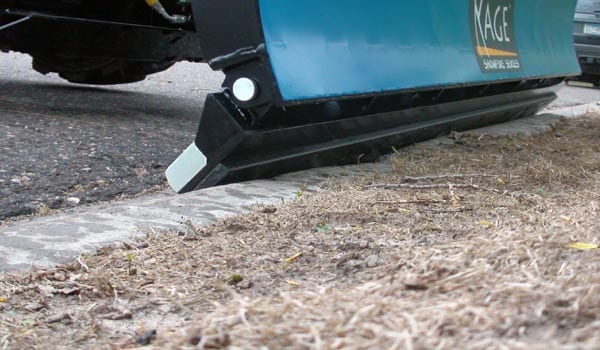Trip Happens…
Stuff jumps out at you, obstacles become unavoidable, trip happens. You name it, plow operators will hit it. The trip function not only protects machines and plows, but their operators too. ‘Trip’ mechanism deploy when the plow actually strikes something that is immobile allowing you to continue plowing without having to stop and reset.
Trip Edge Advantages
Trip edges rarely false trip. Only a heavy impact will cause the trip edge plow to engage making the plowing experience more safe and comfortable for the operator and also easier on the plow and machine.
The operator can apply down pressure to a trip edge plow without actually tripping it from said pressure. This allows the plow to make a much better scrape across your substrate.
A trip edge allows you to keep on going without bringing you to a standstill.
 The KAGE SnowFire blade features a tall, 9″ safety trip-edge standard. Accidental damage is prevented when running into hidden obstacles by tripping back 68 degrees. Four compression style return springs allow the cutting edge to trip when you need it and stays where it is when you don’t.
The KAGE SnowFire blade features a tall, 9″ safety trip-edge standard. Accidental damage is prevented when running into hidden obstacles by tripping back 68 degrees. Four compression style return springs allow the cutting edge to trip when you need it and stays where it is when you don’t.
The trip edges are built to withstand the abuse of contractors or operators that don’t have a minute to waste.
Trip Edge vs. Full Trip
With a full trip edge, the plow is more susceptible to false tripping – which means more loads being lost and more time being wasted.
False tripping on a full trip edge causes the operator to have to back up, reset, and move forward again, costing valuable time.
The ability to scrape the substrate diminishes with full trip plows because they should never have full down pressure applied to avoid false tripping. Check out what others are saying about trip edges.
Learn more about the SnowFire blade that comes standard with the trip edge or buy it online click here.
Be sure to follow us on Instagram, YouTube, Facebook, LinkedIn, and Twitter to keep up-to-date will all things KAGE.

Recent Comments